The Taiga
The Taiga is a wilderness survival video game that uses simulation to give the player an accurate wilderness survival experience.
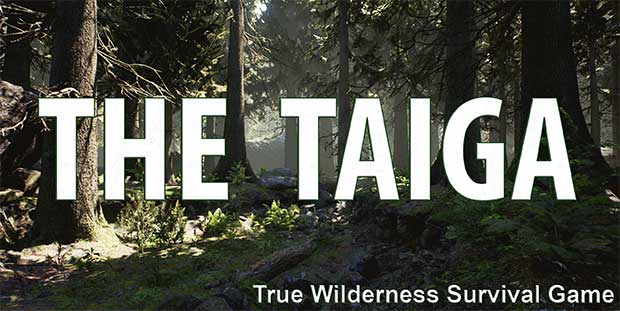
| Genre: |
Wilderness Survival
Simulation
|
| Perspective: |
First Person
VR Enabled
|
| Platforms: |
PC
MAC
XBox
Playstation
|
| Players: |
Multiplayer
Singleplayer
|
- Simulated Body function
- Simulated Nutrition
- Accurate Macro Nutrients
- Digestive System
- Crafting
- Hunting, Trapping, Farming
- Body Temperature
- Massive Open World
- Accurate Plant life
- Animals
- Insects
- Simulated Weather
- Seasons
- Sky Simulator
- e.t.c...
The Taiga is the ultimate man vs nature game. The game has no zombies, monsters, or mutants. Just the harsh realities of mother nature as you play in the shoes of a fur-trading Voyageur.
KEEP SCROLLING FOR MORE DETAILS
Setting
Fur Trade Era
The game takes place in the late fur trading epoch of North America, in the heart of Ruperts Land, when the Hudsons Bay Company still covered most of what is now Canada.
French Voyageurs, who where employed by the Hudson Bay, would depart with birch bark canoes from Montreal. They would cross Canada to pick up furs from outposts which where replenished by First Nation trappers.
Les Hiventants
By the late 1800's some of the French Voyageurs would stop coming back to Montreal for the winter and remain in the region. These would be known as Hivenants (Winterers).
A lot of these Hivenants married with First Nations and became parents of the Metis culture which is a mix of French and First Nations culture. Speaking Mechif, a mix of French and Cree dialect.
Food Simulator
Calories
The player burns calories. Depending what they are currently doing, different amounts of calories will be burned. This system simulates real life calorie burning and storage as much as possible.
Macro Nutrients
Unlike other wilderness survival games, The Taiga simulates real life nutrition and macro nutrients. E.I. Players are not able to survive on just eating meat, which could lead to diseases like scruvy.
The simulator considers macro nutrients, such as:
- Protein
- Fats
- Carbohydrates
- Vitamins
- Minerals
- Electrolytes
- e.t.c...
The Taiga uses accurate macro values for all food, as much as possible. Even for the wild plants and insects!
Enviroment
The world is be made up of the real life plants, mushrooms, insects and animals that are found in the boreal forest.
Mushrooms
Indentifying
Instead of just naming the mushroom, an in-game system allows the player to rotate and inspect mushrooms visually in order to identify mushrooms manually. Consequently, the player has to learn to identify mushrooms to be able to identify them in the game and use them in the game.
Toxicity
In the game, eating poisonous mushrooms such as the Destroying Angle causes renal failure and is deadly. Some mushrooms might have hallucinogens and can cause hallucinations.
Edibility
Like the plants and meat, the mushrooms use accurate nutritional values in the game.
Animals
Animals are found in their real habitable locations and follow seasonal migrations. Wind direction affects what animals detect through smell. Prints on the ground and animal droppings help in tracking and identifying animals.
Animal AI tries to simulate the real behaviors and living patterns of each animal.
Night Sky Simulator
The night sky in The Taiga simulates earths night sky. This means that the position of the stars are be dependent on time, season, and the position of the player.
The player is able to use the stars to navigate as they would be able to do so in real life.
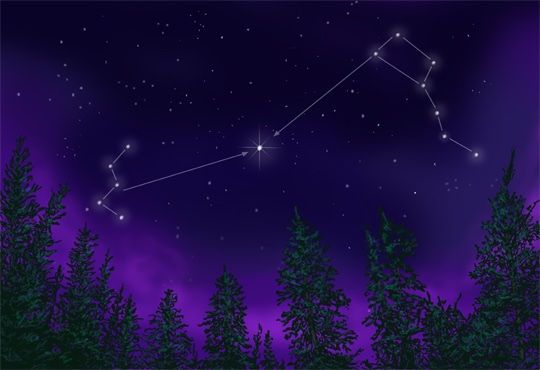 Finding North
Finding North
Like in real life, some types of plants, moss, or animals can also give clues as to where north is.
Day Sky Simulator
The position of the sun in the game simulate the sun on earth. In the game, the sun position is dependent on the time, season, and the current position of the player. The player is able to use the position of the sun to tell time and for navigation.
Weather
In order to have a realistic weather system and not rely on random factors, the world in The Taiga defines it's weather by simulating cold and warm fronts, humidex, temperature, el nino and air pressure.
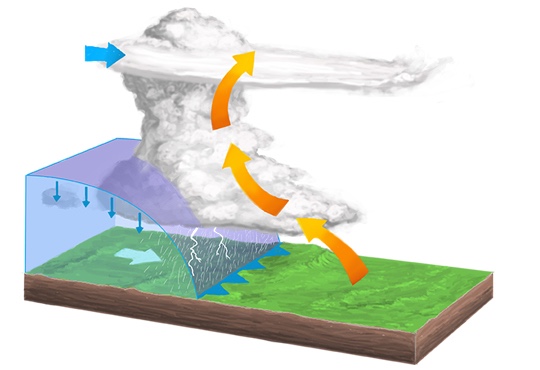 Simulated Weather
Simulated Weather
The weather experienced is also depend on seasons. The clouds the player sees are dependent on the weather.
Inventory
Unlike other games in this genre, the player is not be able to hold ridiculous amounts of inventory and has to drag larger objects.
The Taiga uses specific controls, making world interaction intuitive and easy.
Temperature and Warmth
In the game, the player needs to protect themselves from hypothermia. Body heat loss is simulated through the heat transfer methods of evaporation, conduction, convection and radiation.
If the player is wet, they loose body heat through evaporation as they dry.
The player can regulate their body temperature through clothing, shelters, fires, metabolism, e.t.c...
Crafting And Building
The Taiga simulates real life crafting. E.I. rope and and string needs to be crafted from the plants that they are crafted with in real life.
E.i. In The Taiga, rope can be made from stinging neddle fibres, spruce root, bark in lye solution, e.t.c....
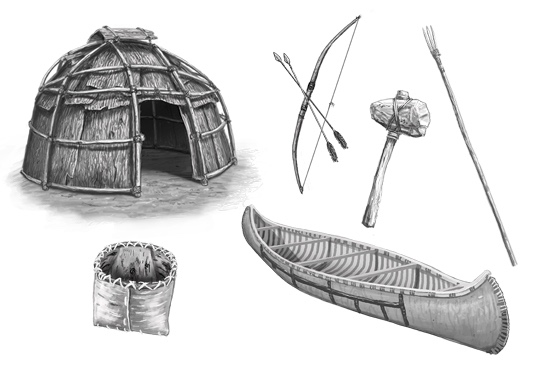 Crafting
Crafting
The player also has to build tools, hunting weapons, and shelters. The player can also build things like a birch bark canoe or a wheel barrel. The birch bark canoe is built with the same components as it is in real life, e.i. with birch bark, spruce root, pine pitch, cedar ribs and lining e.t.c...
Trapping and Hunting
The player is able to put up different types of snares and traps to trap wild animals. Fish traps can also be constructed.
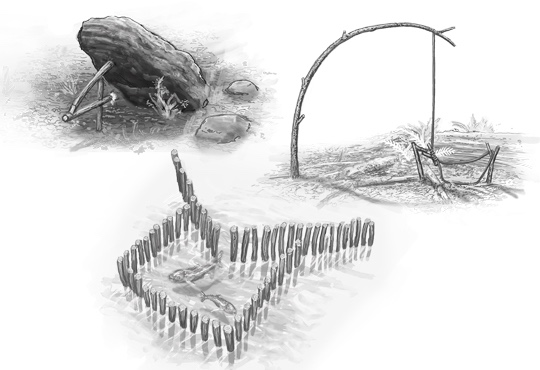 Trapping
Trapping
The player can also trap, hunt, fish and forage for food. The player is also able to grow food and farm.
Life Cycles
All objects in the game have a life cycle. E.i. different plants will have flowers, fruits or seeds depending on the time of the season. Mushrooms will go through their growth cycle and can be harder to identify when younger.
Player Organ Function
The Taiga simulates human organ function and nutrition absorption as closely as possible. So the player does not absorb the nutrients as soon as consumed. They will be first processed by the stomach then works it's way through the rest of the digestive system.
If the player cosumes a poisonous mushroom, depending on the type of mushroom, the players kidney may take 24 hours to stop functioning.
If the player contracts an infection from infected water such as giardia, they will suffer the consequeces of giardia and have a hard time retaining water.
Vitamins
The real vitamin values of meats, plants and mushrooms are used in the game. Diseases can ale the player when the player is missing certain nutrition overtime. E.i. Vitamin C Deficiencies will bring on real life ailments such as scurvy and low immune function.
Medicines will also be able to be extracted from different plants. E.i. aspirin from white willow bark or vitamin C tea from spruce or other plants. The native-Americans used to use spruce tea to ward off Scurvy.
Cooking and Food preservation
Everything in the game has a life cycle, the player need to store food for the future and for the hard winter months. An example of food preservation, the player is able to build a smoker, or a drying rack to dry some plants and meats.
The player can make pemmican from jerky, berries, and animal fat. Or bannock from flour. The player will also be able to build and store food in a root cellar once well established.
Multiplayer
The game can be played in singleplayer or multiplayer.
While playing in multiplayer, the players can work together to survive. They can build communities and trade with one another. Some player may even choose to attack other players to steal their possesions.
North American History
Fur Trading Epoch
The game is set in the early fur trading epoch of North America, more precisely in what was called Rupert's Land.
Rupert's Land was the vast territories attributed to Hudson's Bay Company from 1670 to 1870. This territory took up about a 1/3rd of what is now Canada.
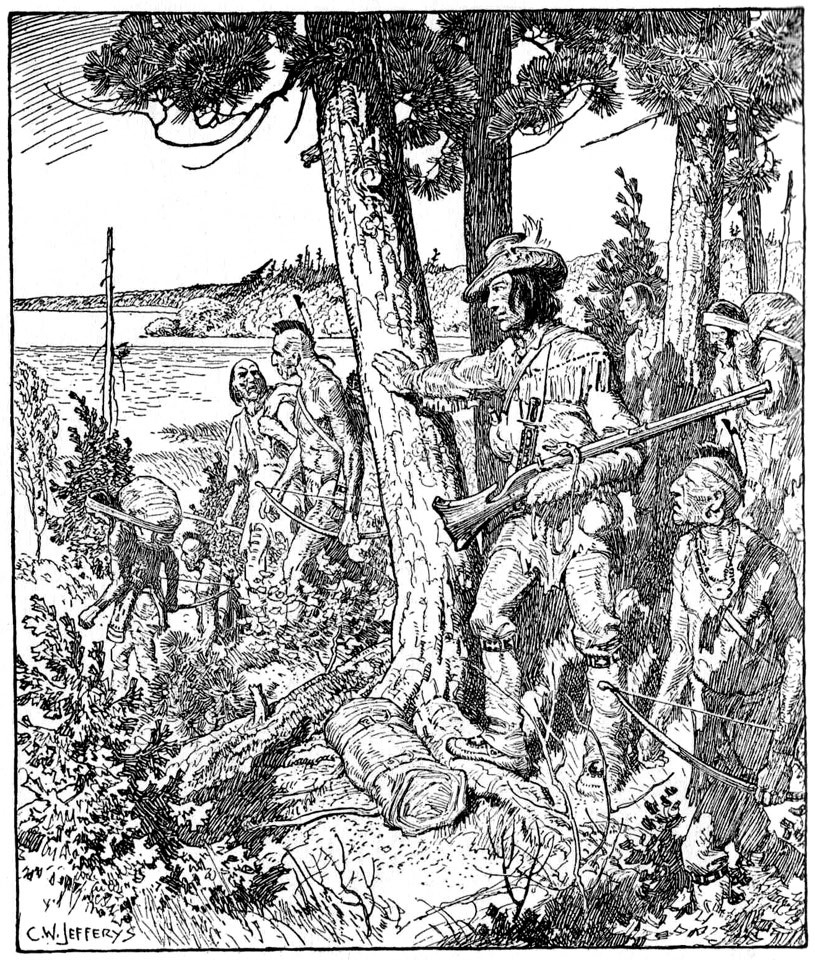 Charles William Jefferys / BIBLIOTHÈQUE et ARCHIVES Canada / C-073635
Charles William Jefferys / BIBLIOTHÈQUE et ARCHIVES Canada / C-073635
The First Nations, Métis, and French courreurs des bois, would trap during the winter and trade their pelts with the Hudson's Bay Company for supplies and goods.
The mix of First nations and French created new languages, like the Métis Méchif language (a langauge made up of French and Cree)
Some metis eventually settled down on lands where they would farm and build communities (Like Batoche).
First Nations Culture
Despite its harsh conditions, Fist Nations people have been able to thrive in the boreal forest for countless generations. It is not for nothing that in our game, we have borrowed a lot of prehistoric and historic First Nations techniques for survival.
Our name Kotawan is the Native American Cree word for Campfire.
We hope that our game can bring an attention to Canadian History, namely Native American culture, as well as bring an understanding of how people have been able to survive from what nature provides.